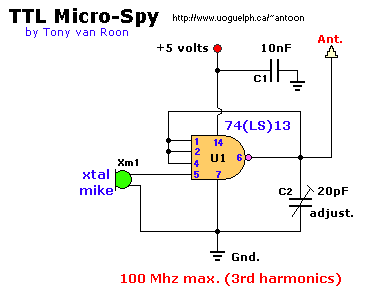
Parts List:
C1 = 10nF, ceramic. Preferable NPO type
C2 = 20pF adjustable trimmer cap
IC1 = 74LS13
Xm = Crystal Mike (see text)
Ant = Almost anything will work (see text)
Couple Notes:
This circuit is old (70's) but since the 74LS13 is from the regular 74xx series and easy to obtain, I decided to keep
the circuit in place until components are no longer available.
Not much to tell here. Performance is based on the 74LS13, a 'Dual 4-input Positive-Nand Schmitt Trigger'. This circuit
was experimental and so has no real purpose other than tinkering. But with only 4 parts, it works. Working on the
3rd harmonics (100MHz) and with the parts shown, it sends anything it picks up to a regular radio. It may take a bit of
experimentation to find the right frequency on your radio. I used an old mechanical alarm clock (with those large bells)
and put the microphone close to it. That allowed me to find the "tick-tack" signal on my radio at my leisure. The
adjustable trimmer cap (C2) will fine-tune performance and sensitivity a bit by balancing the output signal to ground.
Sound is picked up by the mike and fed to pin 5 which acts as a pre-amp stage. The other 3 inputs are configured to
send out the amplified signal.
The crystal mike is actually one of those 'oldie' large clumsy pink ear pieces which where popular in the 70's. They
are still available at Tandy/RadioShack or your local electronics parts shop. To use as a microphone, unscrew the
plastic earpiece.
As you probably already noticed the power, and consequently the transmitting distance, is small. I believe if I
remember well at the most 10 to 30 feet or so but depends on the antenna and input voltage. I used a piece of thin,
12" piano wire. But use whatever performs best. Regular wire can also be used.
Voltage to the circuit must not exceed 7 volts for the 'LS' type. However, for the regular 7413 model that is
only 5.5 volts. C1 is decoupling any posible little spikes on the power rail.
Back to Circuits page
Copyright © Tony van Roon

